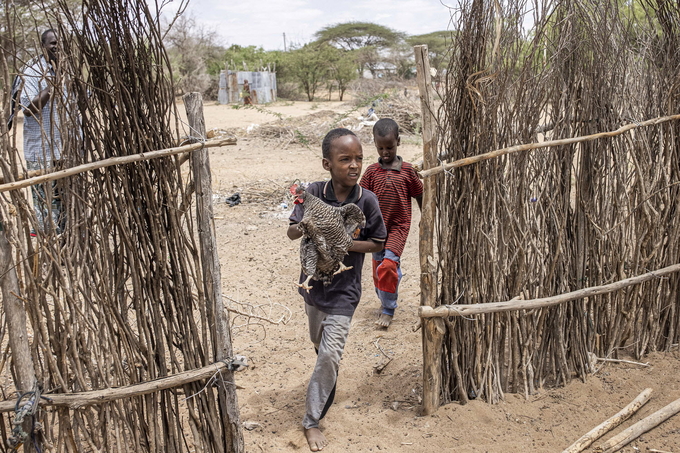May 18, 2025 | 17:17 GMT +7
May 18, 2025 | 17:17 GMT +7
Hotline: 0913.378.918
May 18, 2025 | 17:17 GMT +7
Hotline: 0913.378.918

Child wasting has life-long consequences not just for health but also for human capital and economic development, prosperity and social equity.
Enhancing nutrition in emergency agriculture responses and building resilience of the most vulnerable populations can break the vicious cycle of distress that underlies child wasting, the Food and Agriculture Organization of the United Nations (FAO) said today as it launched its new child wasting prevention action plan.
With the plan, FAO intends to scale up and improve efforts to tackle child wasting by enhancing the/a nutrition component in the humanitarian response and development assistance targeting primarily households with at-risk children, pregnant and lactating women and girls.
To implement this, FAO requires $500 million for the period of 2023–2024 to assist one million households in the 15 most-affected countries. These countries hosting 27 million children in severe food insecurity and at high risk of becoming wasted are: Afghanistan, Burkina Faso, Chad, Democratic Republic of the Congo, Ethiopia, Haiti, Kenya, Madagascar, Mali, the Niger, Nigeria, Somalia, South Sudan, the Sudan and Yemen.
“We urgently need to complement lifesaving interventions with a prevention strategy that will keep those recovered children out of wasting and prevent future cases in communities and households most at risk,” said FAO Director-General QU Dongyu in the foreword to the action plan. “The time is urgent to enable communities themselves to bridge the divide between short-term humanitarian assistance, and the prevention-focused development activities. It is only by sustainably decreasing acute food insecurity that we can prevent the scourge of child wasting in the longer term.”
Child wasting is on the rise
Child wasting persists at alarming rates. In 2020, 47 million children were already wasted. The lingering effects of the COVID-19 pandemic shutdowns and now the food and fuel price crisis are exacerbating the situation, further deepening poverty and worsening food insecurity and malnutrition for millions of people.
New action plan
Child wasting is a major health problem with life-long consequences not just for well-being but also for human capital and economic development, prosperity and social equity. FAO’s commitment on child wasting is to ensure that children are breastfed then have access to an adequate and diverse diet in the first years of their lives by supporting agrifood systems that provide healthy and nutritious food to meet the needs of children and women.
FAO’s action plan will deliver three key outputs:
Agrifood system interventions to prevent child wasting will be scaled up. FAO will focus on small-scale farming and home gardening, small animal husbandry, food and nutrition education (including support to breastfeeding and infant and young child feeding), food safety measures (including animal treatment, food handling, storage and minimal processing), and cash-based interventions such as cash+.
Skills and knowledge on gender-sensitive and nutritious production will be enhanced. To maximize the nutritional impact, FAO’s response will promote production and consumption of nutrient rich crops and high nutritious livestock products (iron, vitamins A and C, zinc), which also provide energy and protein. Particular attention will be given to support a combination of productive and income-generating activities in order to diversify livelihoods and provide more regular sources of income to protect and develop productive assets in rural areas.
Food security analysis, coordination and information management will be ensured. The constant monitoring of the food security situation and the integration of food and dietary data is key to understand the risk factors of child wasting and support the tailoring and evaluation of preventive strategies.
This strategic approach will be implemented in close collaboration and coordination with national governments and the United Nations agencies and partners.
The new plan of action will contribute to the Global Action Plan on Child Wasting, commissioned in 2019 by the Secretary-General of the United Nations António Guterres. The plan brought together five UN agencies: FAO, the Office of the High Commissioner for Refugees (UNHCR), the United Nations Children’s Fund (UNICEF), the World Food Programme (WFP) and the World Health Organization (WHO). The agencies are committed to coordinate and concentrate their actions to ensure that households with children in situations of vulnerability are enabled to access safe and nutritious food and the services (including addressing specific nutrition issues such as anaemia among women and girls) needed to prevent wasting and ensure that recovered children do not fall back into wasting.
(FAO.org)

(VAN) Fourth most important food crop in peril as Latin America and Caribbean suffer from slow-onset climate disaster.

(VAN) Shifting market dynamics and the noise around new legislation has propelled Trouw Nutrition’s research around early life nutrition in poultry. Today, it continues to be a key area of research.

(VAN) India is concerned about its food security and the livelihoods of its farmers if more US food imports are allowed.

(VAN) FAO's Director-General emphasises the need to work together to transform agrifood systems.

(VAN) Europe is facing its worst outbreak of foot-and-mouth since the start of the century.

(VAN) The central authorities, in early April, released a 10-year plan for rural vitalization.

(VAN) Viterra marked a significant milestone in its carbon measurement program in Argentina, called Ígaris, reaching 1 million soybean hectares measured.